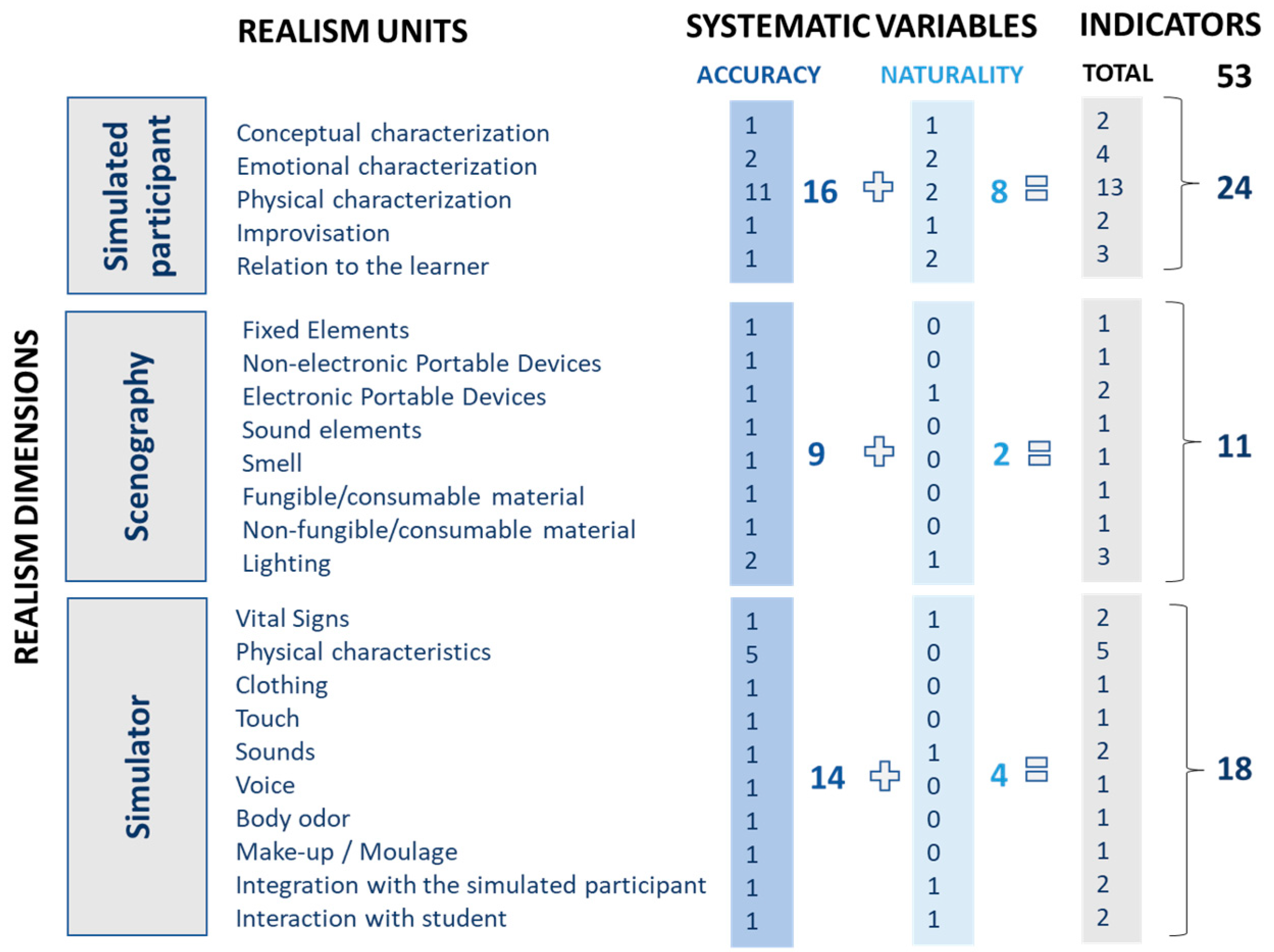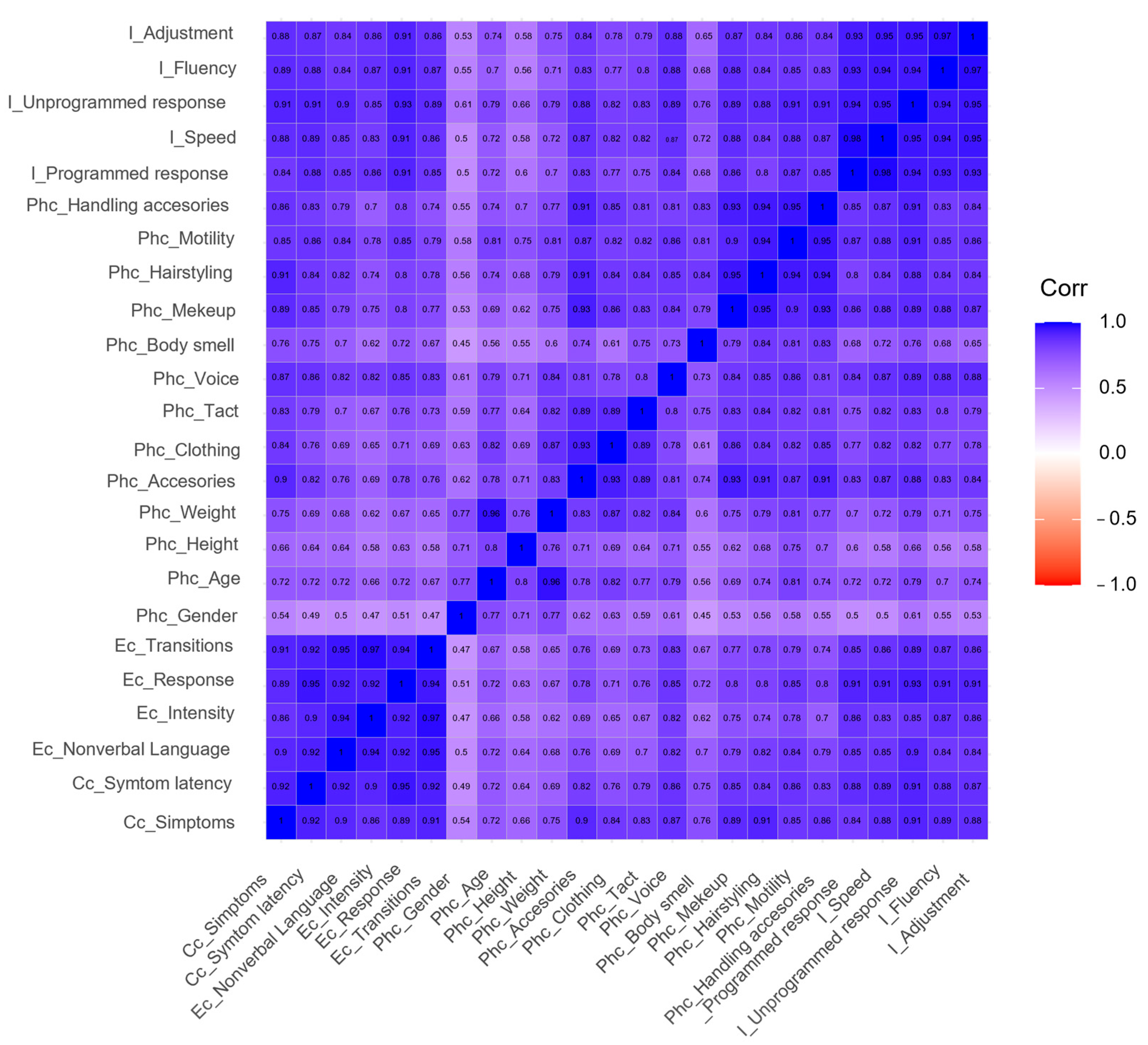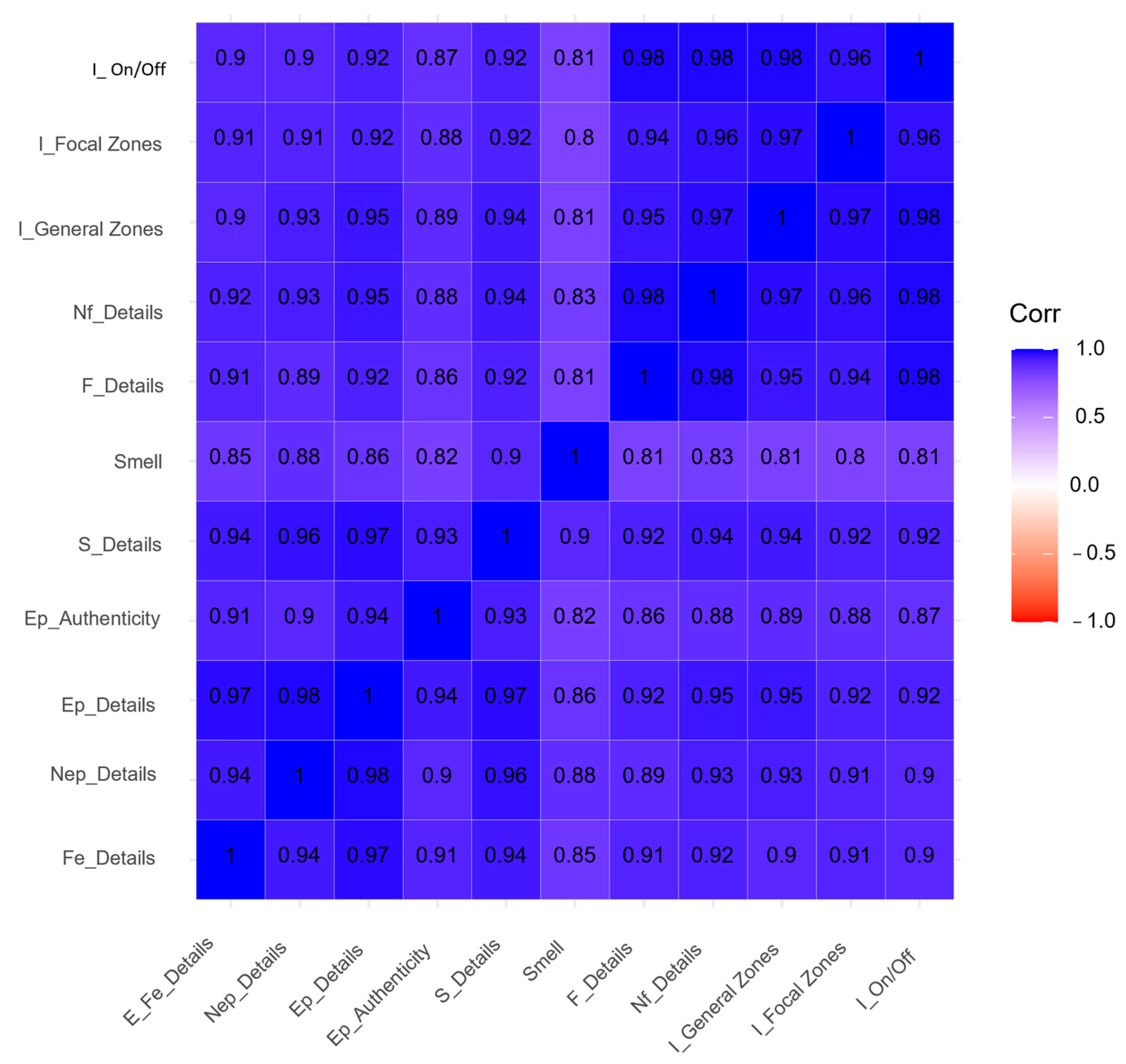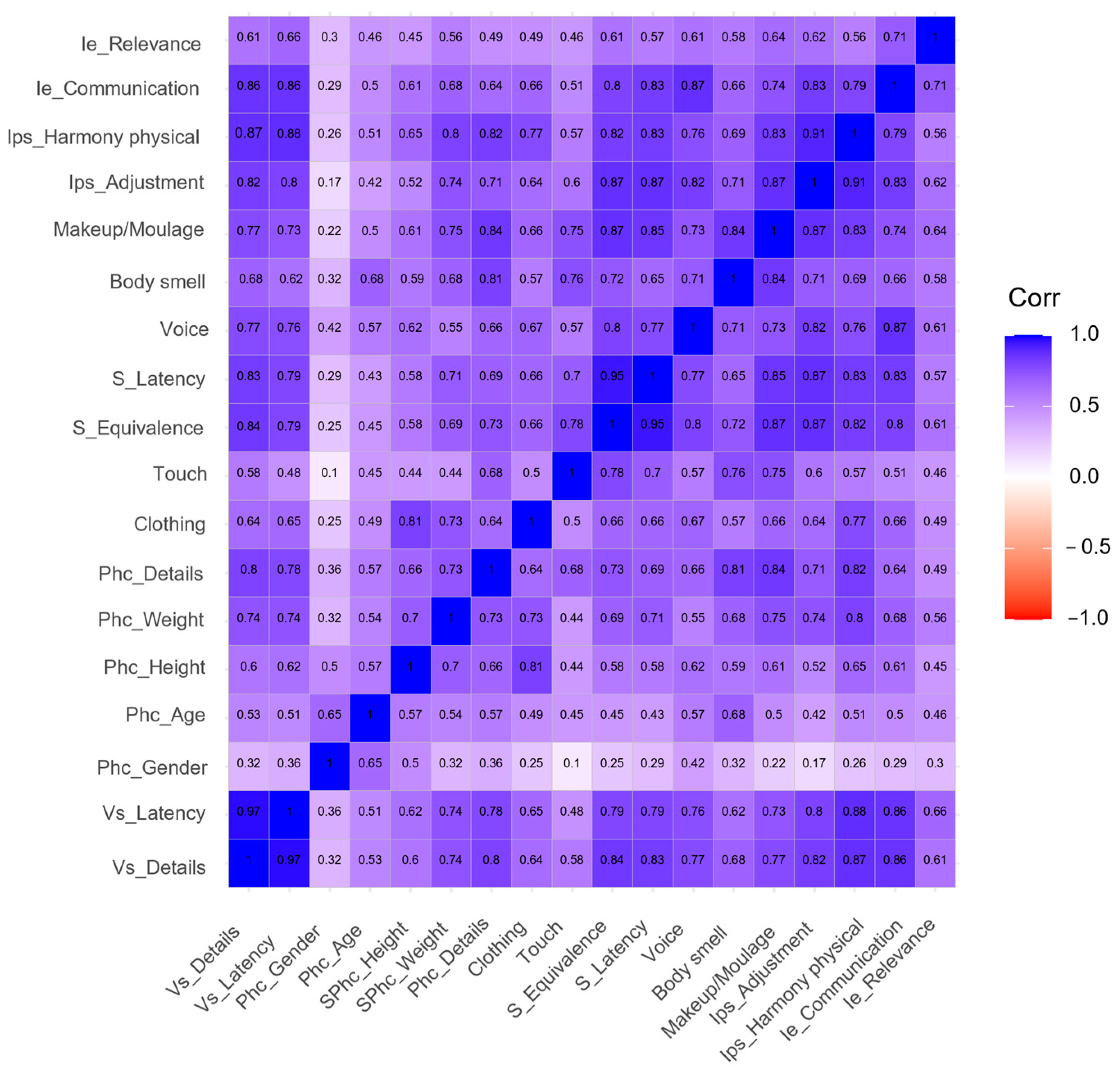Numerical Assessment Tool to Measure Realism in Clinical Simulation
Abstract
1. Introduction
2. Materials and Methods
2.1. Qualitative Study: Delphi Method
2.2. Quantitative Study: Sample Characteristics
- 1–3.5 very low
- 3.5–5 low
- 5–7 average
- 7–8.5 high
- 8.5–10 very high.
2.3. Statistical Analysis
- 20% Simulator—less impactful weight due to the numerous reviewed studies that suggest that the simulator has the least impact on realism, due to the great variety of typologies and challenge in reproducing all aspects of the real patient. Some systematic reviews suggest that the efficacy of the simulation depends more on the training level of the students than on the realism of the simulator [22,23,24].
- 30% Scenography—remaining percentage, but with significant weight, considering the relevance facilities and material elements have when composing ambiance to facilitate immersion of those participating in the scenario [25].
3. Results
4. Discussion
5. Conclusions
Author Contributions
Funding
Institutional Review Board Statement
Informed Consent Statement
Data Availability Statement
Acknowledgments
Conflicts of Interest
References
- Conlon, M.M.; McIntosh, G.L. Perceptions of realism in digital scenarios: A mixed methods descriptive study. Nurse Educ. Pract. 2020, 46, 102–794. [Google Scholar] [CrossRef] [PubMed]
- Nanji, K.C.; Baca, K.; Raemer, D.B. The effect of an olfactory and visual cue on realism and engagement in a health care simulation experience. Simul. Healthc. 2013, 8, 143–147. [Google Scholar] [CrossRef] [PubMed]
- Mills, B.W.; Miles, A.K.; Phan, T.; Dykstra, P.M.C.; Hansen, S.S.; Walsh, A.S.; Reid, D.N.; Langdon, C. Investigating the extent realistic moulage impacts on immersion and performance among undergraduate paramedicine students in a simulation-based trauma scenario: A pilot study. Simul. Healthc. 2018, 13, 331–340. [Google Scholar] [CrossRef] [PubMed]
- Tun, J.K.; Alinier, G.; Tang, J.; Kneebone, R.L. Redefining Simulation Fidelity for Healthcare Education. Simul. Gaming 2015, 46, 159–174. [Google Scholar] [CrossRef]
- Yuan, H.B.; Williams, B.A.; Fang, J.B. The contribution of high-fidelity simulation to nursing students’ confidence and competence: A systematic review. Int. Nurs. Rev. 2012, 59, 26–33. [Google Scholar] [CrossRef]
- Alsaad, A.A.; Davuluri, S.; Bhide, V.Y.; Lannen, A.M.; Maniaci, M.J. Assessing the performance and satisfaction of medical residents utilizing standardized patient versus mannequin-simulated training. Adv. Med. Educ. Pract. 2017, 8, 481–486. [Google Scholar] [CrossRef]
- O’Leary, F.; Pegiazoglou, I.; McGarvey, K.; Novakov, R.; Wolfsberger, I.; Peat, J. Realism in paediatric emergency simulations: A prospective comparison of in situ, low fidelity and centre-based, high fidelity scenarios. Emerg. Med Australas. 2018, 30, 81–88. [Google Scholar] [CrossRef]
- Gormley, G.; Sterling, M.; Menary, A.; McKeown, G. Keeping it real! Enhancing realism in standardised patient OSCE stations. Clin. Teach. 2012, 9, 382–386. [Google Scholar] [CrossRef]
- Vaughn, J.; Lister, M.; Shaw, R.J. Piloting Augmented Reality Technology to Enhance Realism in Clinical Simulation. Comput. Inform. Nurs. 2016, 34, 402–405. [Google Scholar] [CrossRef]
- Gillett, B.; Peckle, B.; Sinert, R.; Onkst, C.; Nabors, S.; Issley, S.; Maguire, C.; Galwankarm, S.; Arquilla, B. Simulation in a disaster drill: Comparison of high-fidelity simulators versus trained actors. Acad. Emerg. Med. 2008, 15, 1144–1151. [Google Scholar] [CrossRef]
- Paige, J.B.; Morin, K.H. Simulation fidelity and cueing: A systematic review of the literature. Clin. Simul. Nurs. 2013, 9, 481–489. [Google Scholar] [CrossRef]
- Lewis, K.L.; Bohnert, C.A.; Gammon, W.L.; Hölzer, H.; Lyman, L.; Smith, C.; Thompson, T.M.; Wallace, A.; Gliva-McConvey, G. The Association of Standardized Patient Educators (ASPE) Standards of Best Practice (SOBP). Adv. Simul. 2017, 2, 1–8. [Google Scholar] [CrossRef] [PubMed]
- Jensen, S.; Nøhr, C.; Rasmussen, S.L. Fidelity in clinical simulation: How low can you go? Stud. Health Technol. Inform. 2013, 194, 147–153. [Google Scholar] [PubMed]
- Everett-Thomas, R.; Turnbull-Horton, V.; Valdes, B.; Valdes, G.R.; Rosen, L.F.; Birnbach, D.J. The influence of high fidelity simulation on first responders retention of CPR knowledge. Appl. Nurs. Res. 2016, 30, 94–97. [Google Scholar] [CrossRef] [PubMed]
- Secheresse, T.; Usseglio, P.; Jorioz, C.; Habold, D. Simulation haute-fidélité et sentiment d’efficacité personnelle. Une approche pour appréhender l’intérêt de la simulation en santé. Anesthésie Réanimation 2016, 2, 88–95. [Google Scholar] [CrossRef]
- Bandura, A. Auto-efficacité: Le sentiment d’efficacité personnelle. L’orientation Sc. Prof. 2004, 33, 3–5. [Google Scholar] [CrossRef]
- Coro-Montanet, G.; Bartolomé-Villar, B.; García-Hoyos, F.; Sánchez-Ituarte, J.; Torres-Moreta, L.; Méndez-Zunino, M.; Morales Morillo, M.; Pardo Monedero, M.J. Indicadores para medir fidelidad en escenarios simulados. Rev. Fund. Educ. Médica 2020, 23, 141–149. [Google Scholar] [CrossRef]
- Rudolph, J.W.; Raemer, D.B.; Simon, R. Establishing a safe container for learning in simulation: The role of the pre-simulation briefing. Simul. Healthc. 2014, 9, 339–349. [Google Scholar] [CrossRef]
- Bisquerra, R.; Pérez-Escoda, N. ¿Pueden las escalas Likert aumentar en sensibilidad? Rev. D’innovació I Recer. Educ. 2015, 8, 129–147. [Google Scholar] [CrossRef]
- Rethans, J.-J.; Gorter, S.; Bokken, L.; Morrison, L. Unannounced standardised patients in real practice: A systematic literature review. Med. Educ. 2007, 41, 537–549. [Google Scholar] [CrossRef]
- Defenbaugh, N.; Chikotas, N.E. The outcome of interprofessional education: Integrating communication studies into a standardized patient experience for advanced practice nursing students. Nurse Educ. Pract. 2015, 16, 176–181. [Google Scholar] [CrossRef] [PubMed]
- Alinier, G. A typology of educationally focused medical simulation tools. Med. Teach. 2007, 29, 243–250. [Google Scholar] [CrossRef]
- Fritz, P.Z.; Gray, T.; Flanagan, B. Review of mannequin-based high-fidelity simulation in emergency medicine. Emerg. Med. Australas. 2008, 20, 1–9. [Google Scholar] [CrossRef] [PubMed]
- Lefor, A.K.; Harada, K.; Kawahira, H.; Mitsuishi, M. The effect of simulator fidelity on procedure skill training: A literature review. Int. J. Med. Educ. 2020, 11, 97. [Google Scholar] [CrossRef] [PubMed]
- Graham, A.C.; McAleer, S. An overview of realistic assessment for simulation-based education. Adv. Simul. 2018, 3, 13. [Google Scholar] [CrossRef] [PubMed]
- Georg, D.; Mallery, P. IBM SPSS Statistics 26 Step by Step: A Simple Guide and Reference, 16th ed.; Routledge: New York, NY, USA, 2019. [Google Scholar]
- Wilson, E.; Hewett, D.G.; Jolly, B.C.; Janssens, S.; Beckmann, M.M. Is that realistic? The development of a realism assessment questionnaire and its application in appraising three simulators for a gynaecology procedure. Adv. Simul. 2018, 3, 21. [Google Scholar] [CrossRef]
- Singh, D.; Kojima, T.; Gurnaney, H.; Deutsch, E.S. Do Fellows and Faculty Share the Same Perception of Simulation Fidelity? A Pilot Study. Simul. Healthc. 2020, 15, 266–270. [Google Scholar] [CrossRef]
- Bredmose, P.P.; Habig, K.; Davies, G.; Grier, G.; Lockey, D.J. Scenario based outdoor simulation in pre-hospital trauma care using a simple mannequin model. Scand. J. Trauma Resusc. Emerg. Med. 2010, 18, 13. [Google Scholar] [CrossRef]
- Lapkin, S.; Levett-Jones, T. A cost–utility analysis of medium vs. high-fidelity human patient simulation manikins in nursing education. J. Clin. Nurs. 2011, 20, 3543–3552. [Google Scholar] [CrossRef]
- Lee, k.; Grantham, H.; Boyd, R. Comparison of high- and low-fidelity mannequins for clinical performance assessment. Emerg. Med. Australas. 2009, 20, 515–530. [Google Scholar] [CrossRef]
- Levett-Jones, T.; McCoy, M.; Lapkin, S.; Noble, D.; Hoffman, K.; Dempsey, J.; Arthur, C.; Roche, J. The development and psychometric testing of the Simulation Satisfaction Experience Scale. Nurse. Educ. Today 2011, 31, 705–710. [Google Scholar] [CrossRef]
- Norman, G.; Dore, K.; Grierson, L. The minimal relationship between simulation fidelity and transfer of learning. Med. Educ. 2012, 46, 636–647. [Google Scholar] [CrossRef] [PubMed]
- Dieckmann, P.; Gaba, D.; Rall, M. Deepening the theoretical foundations of patient simulation as social practice. Simul. Healthc. 2007, 2, 183–193. [Google Scholar] [CrossRef] [PubMed]
- Reis, H.; Judd, C.M. Handbook of Research Methods in Social and Personality Psychology; Cambridge University Press: New York, NY, USA, 2000. [Google Scholar]
- Scerbo, M.W.; Dawson, S. High fidelity, high performance? Simul. Healthc. 2007, 2, 224–230. [Google Scholar] [CrossRef]
- Schoenherr, J.R.; Hamstra, S.J. Beyond fidelity: Deconstructing the seductive simplicity of fidelity in simulator-based education in the health care professions. Simul. Healthc. 2017, 12, 117–123. [Google Scholar] [CrossRef] [PubMed]
- Yu, C.-Y. Evaluating Cut off Criteria of Model Fit Indices for Latent Variable Models with Binary and Continuous Outcomes. Unpublished. Doctoral Dissertation, University of California, Los Angeles, CA, USA, 2002. Available online: http://www.statmodel.com/download/Yudissertation.pdf (accessed on 12 November 2022).
- Yuan, H.B. Development of student simulated patient training and evaluation indicators in a high-fidelity nursing simulation: A Delphi consensus study. Front. Nurs. 2021, 8, 23–31. [Google Scholar] [CrossRef]
- Garcovich, D.; Zhou Wu, A.; Sanchez Sucar, A.M.; Adobes Martin, M. The online attention to orthodontic research: An Altmetric analysis of the orthodontic journals indexed in the journal citation reports from 2014 to 2018. Prog. Orthod. 2020, 21, 31. [Google Scholar] [CrossRef]




| Scenario | Simulated Participant | Simulator | Scenography |
|---|---|---|---|
| 1. | Professional actor | Advanced | No Gesell chamber |
| 2. | Amateur actor | Basic | No Gesell chamber |
| 3. | Professional actor | Advanced | With Gesell chamber |
| 4. | Amateur actor | Basic | With Gesell chamber |
| 5. | Amateur actor | Advanced | With Gesell chamber |
| 6. | Amateur actor | Advanced | No Gesell chamber |
| 7. | Professional actor | Basic | No Gesell chamber |
| 8. | Professional actor | Basic | With Gesell chamber |
| 1 | 2 | 3 | 4 | 5 | 6 | 7 | 8 | p | n | |
|---|---|---|---|---|---|---|---|---|---|---|
| n = 4 | n = 4 | n = 4 | n = 4 | n = 4 | n = 4 | n = 4 | n = 4 | |||
| Simulated Participant | 9.35 [9.15; 9.52] | 7.83 [7.81; 7.88] | 3.48 [2.56; 4.39] | 6.67 [5.21; 8.29] | 7.88 [7.82; 7.91] | 1.83 [1.17; 2.73] | 8.67 [8.26; 9.15] | 8.71 [8.08; 9.24] | 0.001 | 32 |
| Scenography | 8.55 [8.05; 9.11] | 8.59 [8.45; 8.86] | 1.41 [1.16; 1.66] | 9.50 [9.25; 9.80] | 9.41 [8.91; 9.73] | 2.77 [2.43; 3.41] | 8.14 [6.98; 9.16] | 8.86 [8.27; 9.27] | 0.004 | 32 |
| Simulator | 9.17 [9.01; 9.38] | 7.28 [7.03; 7.43] | 3.78 [3.43; 4.10] | 6.75 [4.99; 8.56] | 7.28 [7.25; 7.54] | 3.89 [3.61; 4.19] | 7.89 [6.79; 8.64] | 7.72 [6.69; 8.57] | 0.002 | 32 |
| Realism Dimensions | raw_alpha | G6 (smc) |
|---|---|---|
| Simulated participant | 0.9884208 | 0.9984726 |
| Scenography | 0.9915374 | 0.996044 |
| Simulator | 0.9698094 | 0.992118 |
| Realism Dimensions | ICC | F | df1 | df2 | P | Lower Bound | Upper Bound |
|---|---|---|---|---|---|---|---|
| Simulated Participant | 0.3639297 | 3.60715 | 23 | 713 | 3.652659 × 10−8 | 0.2072456 | 0.551138 |
| Scenography | 0.1238004 | 2.646275 | 10 | 310 | 0.00413845 | 0.0303881 | 0.3348396 |
| Simulator | 0.8284964 | 14.45182 | 17 | 527 | 3.66863 × 10−34 | 0.7224845 | 0.9107224 |
| Global | 0.6080101 | 6.000236 | 52 | 1612 | 1.071368 × 10−34 | 0.4858323 | 0.7162027 |
| Realism Dimensions | Realism Units | Scenography | Simulator | Simulated Participant |
|---|---|---|---|---|
| Simulated participant | Conceptual characterization | - | - | 0.16972396 |
| Emotional characterization | - | - | 0.14920666 | |
| Physical characteristics | - | 0.06018720 | 0.04449148 | |
| Improvisation | - | - | 0.20160957 | |
| Relation to learner | - | - | 0.45208840 | |
| Scenography | Fixed elements | 0.16038670 | - | - |
| Non-electronic portable devices | 0.14198533 | - | - | |
| Electronic portable devices | 0.14733311 | - | - | |
| Sound elements | 0.16541258 | 0.02889976 | - | |
| Smell | 0.02778539 | 0.03403358 | - | |
| Fungible/consumable material | 0.08664975 | 0.05412197 | - | |
| Non-fungible/consumable material | 0.17775232 | 0.06204755 | - | |
| Lighting | 0.13054525 | 0.06832275 | - | |
| Simulator | Vital Signs | - | 0.05804105 | 0.03612404 |
| Physical characterization | 0.01034069 | 0.06727301 | - | |
| Clothing | 0.02667548 | 0.04371687 | - | |
| Touch | - | 0.09380421 | - | |
| Sounds | - | 0.15384725 | - | |
| Voice | - | 0.08824702 | - | |
| Body odor | - | 0.21539492 | - | |
| Make-up/moulage | - | 0.30332866 | 0.01419659 | |
| Integration with simulated participant | - | 0.15610878 | 0.08019791 | |
| Interaction with student | - | 0.08264757 | - |
Disclaimer/Publisher’s Note: The statements, opinions and data contained in all publications are solely those of the individual author(s) and contributor(s) and not of MDPI and/or the editor(s). MDPI and/or the editor(s) disclaim responsibility for any injury to people or property resulting from any ideas, methods, instructions or products referred to in the content. |
© 2023 by the authors. Licensee MDPI, Basel, Switzerland. This article is an open access article distributed under the terms and conditions of the Creative Commons Attribution (CC BY) license (https://creativecommons.org/licenses/by/4.0/).
Share and Cite
Coro-Montanet, G.; Pardo Monedero, M.J.; Sánchez Ituarte, J.; Wagner Porto Rocha, H.; Gomar Sancho, C. Numerical Assessment Tool to Measure Realism in Clinical Simulation. Int. J. Environ. Res. Public Health 2023, 20, 2247. https://doi.org/10.3390/ijerph20032247
Coro-Montanet G, Pardo Monedero MJ, Sánchez Ituarte J, Wagner Porto Rocha H, Gomar Sancho C. Numerical Assessment Tool to Measure Realism in Clinical Simulation. International Journal of Environmental Research and Public Health. 2023; 20(3):2247. https://doi.org/10.3390/ijerph20032247
Chicago/Turabian StyleCoro-Montanet, Gleyvis, María Jesús Pardo Monedero, Julia Sánchez Ituarte, Helena Wagner Porto Rocha, and Carmen Gomar Sancho. 2023. "Numerical Assessment Tool to Measure Realism in Clinical Simulation" International Journal of Environmental Research and Public Health 20, no. 3: 2247. https://doi.org/10.3390/ijerph20032247
APA StyleCoro-Montanet, G., Pardo Monedero, M. J., Sánchez Ituarte, J., Wagner Porto Rocha, H., & Gomar Sancho, C. (2023). Numerical Assessment Tool to Measure Realism in Clinical Simulation. International Journal of Environmental Research and Public Health, 20(3), 2247. https://doi.org/10.3390/ijerph20032247










